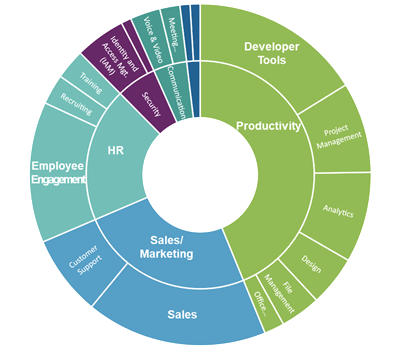The AI-driven “Work 3.0” Transformation

Applying Artificial Intelligence to Resolve the Trade-offs of Remote Work
COVID-19 has transformed the way we work. Chats by the water cooler have been replaced by messages on Slack, brainstorming sessions are now facilitated on virtual boards, and our get-togethers with colleagues have moved to Zoom. Although this is far from “business as usual,” remote work technologies have allowed us to continue to be productive (in some cases, more so than before) throughout the pandemic.
During my summer internship as a Strategy Consultant for IBM, I explored what I call the “remote work transformation,” the user-facing technologies driving it, and the potential for applying IBM Watson’s artificial intelligence (AI), along with advanced analytics and automation, in what a fellow IBM employee coined, the “Work 3.0” transformation. Here’s what I learned…
Privacy and Security are of Paramount Importance
The use of remote work tools like Slack, Zoom, and Webex (also known as the Work 2.0 stack), has increased dramatically during the pandemic. According to an investment report, COVID-19 increased the total addressable market of the Work 2.0 stack by over 60%. The videoconferencing segment, which includes Zoom, was the biggest beneficiary, as its market more than doubled in size from $40 to over $100 billion.
As more users interact with these Work 2.0 technologies, more data is being generated and stored in the Cloud. In a remote work environment, privacy and security become of paramount importance, given the expanded value and volume of the data stored, which in turn increases its susceptibility to attacks. In addition, governments around the world have recently adopted new data privacy laws in response to major data scandals. The increased risk of cyber attacks, coupled with the regulatory shifts, emphasize the importance of protecting company data and the privacy of customers and employees.
Figure 1: The “Work 3.0” Remote Transformation
Over the course of the COVID pandemic, for example, Honda was forced to shut down its global operations due to a ransomware attack, while Marriot was the victim of a data breach that affected 5.2 million customers. Since the pandemic began, more than 170,000 instances of fraud have been reported, with an estimated cost of over $115 million.
The Trade-offs of Remote Work Must NOT be Ignored
Yes, remote work may increase productivity. A survey conducted by Boston Consulting Group indicates that over 75% of remote workers reported maintaining or increasing productivity during the pandemic. Remote work, however, can also have negative repercussions, such as reductions in collaboration and innovation.
A company study revealed that, in a virtual environment, the connections we have with our close colleagues, our “strong ties,” typically get stronger, while the spontaneous interactions with more distant colleagues, our “weak ties,” tend to drop. These “weak ties” have been considered the drivers of innovation: the biggest ideas emerge when two employees who do not normally talk, by chance, connect. That is less likely to happen when everyone is working remotely.
Due to these trade-offs, the remote work transformation should not end with the introduction and usage of the Work 2.0 stack — there must be an added layer of tools leveraging AI, advanced analytics, and automation that are attempting to address these issues. This is what we define as “Work 3.0”. This AI-driven “Work 3.0” transformation is depicted in Figure 1.
New Opportunities for Applying AI are Arising from the Remote Transformation
According to a report by CB Insights, there are over 115 VC-backed startups that are integrating and accessing data from Slack (and other Work 2.0 tools) to derive insights and develop and offer new products and services. These startups are focusing on a variety of business areas and practices that could be impacted by the move to remote work (see Figure 2).
One of these startups, for example, is using AI-powered bots to answer IT and HR-related questions that keep employees productive and “happy”; another is using AI, coupled with advanced analytics, to evaluate customer calls, meetings, and e-mails, that improve the customer experience.
Figure 2: Independent Analysis on “Work 3.0” Impact Areas
My analysis suggests these are areas where data from existing tools is most abundant and which, therefore, represent opportunities to apply AI solutions in order to increase performance. In addition, the broad range of practices that these startups are targeting is indicative of the behavioral changes (increasingly more dependent on technology) emerging from remote work in the last 5 years, which the COVID pandemic has “accelerated by over 18 months.”
During the pandemic, these startups have been adapting quickly to meet market needs, and reaping the business benefits accordingly: about 36% have released new features in response to social distancing measures; 15% announced new partnerships (like integration to other Work 2.0 tools); and 17% raised money (up to $75 million) to improve their AI and other tech offerings.
Figure 3: Activity of “Work 3.0” Startups During the COVID-19 Pandemic
As the post-COVID world continues to become more digital, companies developing AI such as IBM will be a critical engine in driving performance (increasing productivity without sacrificing engagement and innovation) and accelerating the agile transformation of enterprises to enhance resiliency.
Remote work is here to stay, and AI will be a critical element in accelerating and making the most of this transformation.






Juan Carlos — great article! Thank you for previewing how technology is impacting the future of work. I wonder if you see any risks with AI being applied in this way? For example, it is absolutely fascinating to me that AI is being considered as a solution to remote employee engagement — a seemingly depersonalized approach to very human challenge.